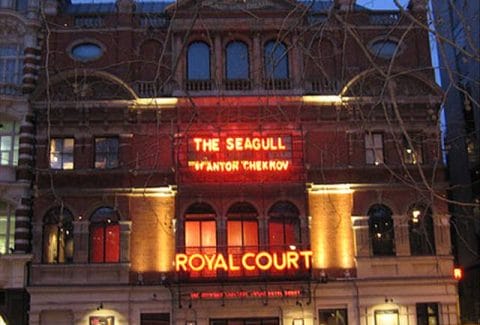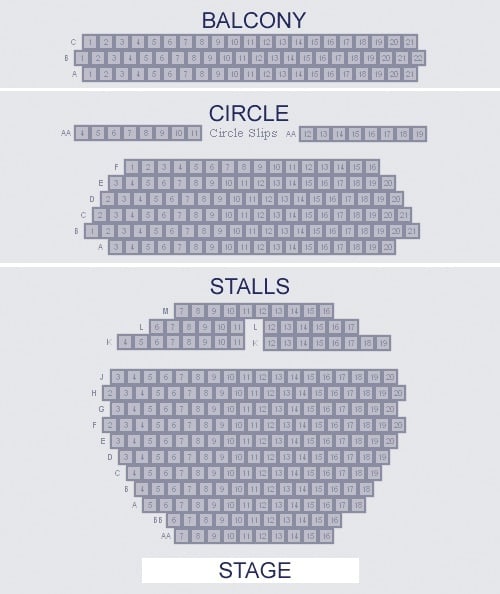The Royal Court Theatre is a non-commercial theatre on Sloane Square, in the Royal Borough of Kensington and Chelsea. It is noted for its contributions to modern theatre. In 1956 it was acquired by and is home to a resident company, the English Stage Company.
HISTORY OF THE ROYAL COURT THEATRE
The Royal Court Theatre is a non-commercial theatre on Sloane Square, in the Royal Borough of Kensington and Chelsea. It is noted for its contributions to modern theatre. In 1956 it was acquired by and is home to a resident company, the English Stage Company.
Several of W. S. Gilbert's early plays were staged here, including Randall's Thumb, Creatures of Impulse (with music by Alberto Randegger), Great Expectations (adapted from the Dickens novel), and On Guard (all in 1871); The Happy Land (1873, with Gilbert Abbott à Beckett; Gilbert's most controversial play); The Wedding March, translated from Un Chapeau de Paille d'Italie by Eugène Marin Labiche (1873); The Blue-Legged Lady, translated from La Dame aux Jambes d'Azur by Labiche and Marc-Michel (1874); and Broken Hearts (1875). By 1878, management of the theatre was shared by John Hare and W. H. Kendal.
Further alterations were made in 1882 by Alexander Peebles, after which its capacity was 728 (including stalls and boxes, dress circle and balcony, amphitheatre, and gallery). After that, Arthur Cecil (who had joined the theatre's company in 1881) was co-manager of the theatre with John Clayton.Among other works, they produced a series of Arthur Wing Pinero's farces, including The Rector, The Magistrate (1885), The Schoolmistress (1886), and Dandy Dick (1887), among others. The theatre closed on 22 July 1887 and was demolished.
The present building was built on the east side of Sloane Square, replacing the earlier building, and opened on 24 September 1888 as the New Court Theatre. It was designed by Walter Emden and Bertie Crewe, constructed of fine red brick, moulded brick, and a stone facade in free Italianate style. It had a capacity of 841 in stalls, dress circle, amphitheatre, and gallery.
Cecil and Clayton had yielded management of the theatre to Mrs. John Wood and Arthur Chudleigh in 1887, although Cecil continued acting in their company (and others) until 1895. The first production at the new theatre was a play by Sydney Grundy called Mamma, starring Mrs. John Wood and John Hare, with Arthur Cecil and Eric Lewis.
Harley Granville-Barker managed the theatre for the first few years of the 20th century, and many of George Bernard Shaw's plays were produced in the early years of the century at the Royal Court. It ceased to be used as a theatre in 1932 but was used as a cinema from 1935 to 1940, until World War II bomb damage closed it.
The interior was reconstructed by Robert Cromie, and the theatre re-opened in 1952, and the number of seats inside was decreased to less than 500 seats. George Devine became artistic director and opened the English Stage Company at the Royal Court in 1956 as a subsidised theatre producing new British and foreign plays, together with some classical revivals. Devine aimed to create a writers' theatre, seeking to discover new writers and produce serious contemporary works, often becoming involved in issues of censorship. He produced John Osborne's Look Back in Anger in 1956, which was later seen as the starting point of modern British drama.
Besides Osborne, Devine premiered works by Arnold Wesker, John Arden, Ann Jellicoe and N. F. Simpson. Subsequent Artistic Directors of the Royal Court premiered work by Christopher Hampton, Athol Fugard, Howard Brenton, Caryl Churchill, Hanif Kureishi, Sarah Daniels, Timberlake Wertenbaker, Martin Crimp, Sarah Kane, Mark Ravenhill, Martin McDonagh, Simon Stephens, Leo Butler, and Edward Bond. Early seasons included new international plays by Bertolt Brecht, Eugene Ionesco, Samuel Beckett, Jean-Paul Sartre, and Marguerite Duras. In addition to the 400-seat proscenium arch Theatre Downstairs, a 63-seat studio Theatre Upstairs was opened in 1969. The Rocky Horror Show premiered there in 1973.
Though the main auditorium and the façade were attractive, the remainder of the building provided poor facilities for both audience and performers, and the stalls and understage often flooded throughout the 20th century. By the early 1990s the theatre had deteriorated dangerously and was threatened with closure in 1995. The Royal Court received a grant of £16.2 million from the National Lottery and the Arts Council for redevelopment, and beginning in 1996 it was completely rebuilt, except for the façade and the intimate auditorium. The theatre reopened in February 2000, with the 380-seat Jerwood Theatre Downstairs, and the 85-seat studio theatre, now the Jerwood Theatre Upstairs. Since 1994, a new generation of playwrights debuting at the theatre has included Joe Penhall, Sarah Kane, Mark Ravenhill, Roy Williams amongst others.
The theatre was Grade II listed in June 1972.
Since 2007, the theatre's Artistic Director has been Dominic Cooke; the Associate Director is Sacha Wares and the deputy artistic director is Jeremy Herrin. Previous Artistic Directors include Ian Rickson (1998 – 2006), Stephen Daldry, Max Stafford-Clark, Stuart Burge, Robert Kidd, Nicholas Wright, Oscar Lewenstein, Lindsay Anderson, Anthony Page, William Gaskill and George Devine. Young writers (between 18 and 25) can apply to the Young Writers' Programme, which seeks to promote works by these young writers.
Over the last decade the Royal Court has placed a renewed emphasis on the development and production of international work. By 1993 the British Council had begun its support of the International Residency programme (which started in 1989 as the Royal Court International Summer School) and by early 1996 a department solely dedicated to international work had been created. A creative dialogue now exists between innovative theatre writers and practitioners in many different countries including Brazil, Cuba, France, Germany, India, Mexico, Nigeria, Palestine, Romania, Russia, Spain, Syria and Uganda. Many of these projects are supported by the British Council and more recently by the Genesis Foundation, who also support the production of international plays. The International Department has been the recipient of a number of awards including the 1999 International Theatre Institute award.






